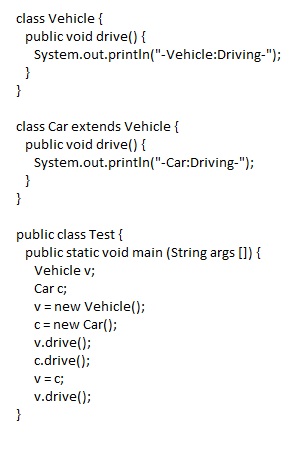Java Study Group Chapter 1
-
A class can ...
-
Extend only a single class and implement only a single interface
-
Extend only a single class but implement multiple interfaces
-
Extend multiple classes but implement only a single interface
-
Extend multiple classes and implement multiple interfaces
-
Explore key Java concepts in this 'Java study group chapter 1' quiz. Dive into understanding the correct syntax order, class inheritance, Java keywords, and method implementations. Ideal for learners aiming to enhance their Java programming skills.
(33).webp)
Quiz Preview
- 2.
Given the following classes defined in separate files:What will the output be on running the Test class?
-
Compiler error for statement v=c
-
Prints: -Vehicle:Driving--Car:Driving--Vehicle:Driving-
-
Runtime exception for statement v=c
-
Prints: -Vehicle:Driving--Car:Driving--Car:Driving-
-
Prints: -Vehicle:Driving--Car:Driving-
Correct Answer
A. Prints: -Vehicle:Driving--Car:Driving--Car:Driving-Explanation
The output will be "Prints: -Vehicle:Driving--Car:Driving--Car:Driving-". This is because the statement "v=c" assigns the object of the Car class to the reference variable v of the Vehicle class. Since the Car class is a subclass of the Vehicle class, it inherits the drive() method from the Vehicle class. Therefore, when the drive() method is called on the object v, it executes the drive() method of the Car class. The output is printed three times because the drive() method is called three times in the Test class.Rate this question:
-
- 3.
What is the correct order?
-
Import, package, class
-
Class, import, package
-
Package, import, class
-
Package, class, import
-
Import, class, package
Correct Answer
A. Package, import, classExplanation
The correct order is package, import, class. In Java, the package statement is used to define the package that the class belongs to. The import statement is used to import other classes or packages that are needed in the current class. Finally, the class statement is used to define the class itself. Therefore, the correct order is to first define the package, then import any necessary classes or packages, and finally define the class.Rate this question:
-
- 4.
Which of the following are Java keywords?
-
Goto
-
Malloc
-
Implementable
-
Extends
-
New
-
Delete
Correct Answer(s)
A. Goto
A. Extends
A. New -
- 5.
Which are true?
-
Abstract interfaces can have final methods.
-
The first concrete subclass must implement all abstract methods of its superclass.
-
Abstract classes cannot have static methods.
-
Interfaces can declare instance variables.
-
A protected method in a superclass that is inherited by a subclass in a different package is now available to all classes in the subclass's package.
Correct Answer(s)
A. The first concrete subclass must implement all abstract methods of its superclass.
A. Abstract classes cannot have static methods.Explanation
The first statement is true. When a class extends an abstract class, it must provide implementations for all the abstract methods defined in the superclass.
The second statement is also true. Abstract classes cannot have static methods because static methods are associated with the class itself, not with any particular instance of the class.
Therefore, the correct answer is that the first concrete subclass must implement all abstract methods of its superclass and abstract classes cannot have static methods.Rate this question:
-
Quiz Review Timeline (Updated): Jun 5, 2023 +
Our quizzes are rigorously reviewed, monitored and continuously updated by our expert board to maintain accuracy, relevance, and timeliness.
-
Current Version
-
Jun 05, 2023Quiz Edited by
ProProfs Editorial Team -
Sep 26, 2010Quiz Created by
K_electron
Informatics Practice Quiz: Exam!
The Informatics Practice Quiz: Exam assesses knowledge in Java programming, focusing on swing controls, operators, loops, and switch-case statements. It is designed to test...
Questions:
10 |
Attempts:
453 |
Last updated:
Mar 19, 2023
|
Java Online Quiz 2
Java Online Quiz 2 assesses knowledge on Java programming basics including data types, variable declarations, and initialization. It is designed for learners to validate their...
Questions:
10 |
Attempts:
422 |
Last updated:
Mar 21, 2023
|
Java Programming Quiz
An interesting Java programming quiz is here for you if you use Java programming or are learning this language. The quiz is not going to be easy in any way. The questions designed...
Questions:
15 |
Attempts:
4778 |
Last updated:
Jul 03, 2023
|
Java Quiz-1
Java Quiz-1 assesses foundational Java programming skills through multiple-choice questions. Topics include constructor behaviors, method definitions, and class hierarchies. Ideal...
Questions:
100 |
Attempts:
5440 |
Last updated:
Sep 18, 2023
|
|
Java Quiz: Test Your GK! Trivia
This Java Quiz tests general knowledge in Java programming, covering topics like data types, access modifiers, OOP concepts, and applets. It assesses key skills for understanding...
Questions:
10 |
Attempts:
1007 |
Last updated:
Mar 22, 2023
|
Can You Answer These Java Programming Questions? Trivia Quiz
Can you answer these java programming questions? There are a lot of people who think that they can never fail any question they are asked when it comes to java programming, and to...
Questions:
10 |
Attempts:
541 |
Last updated:
Mar 22, 2023
|
 Back to top
Back to top









